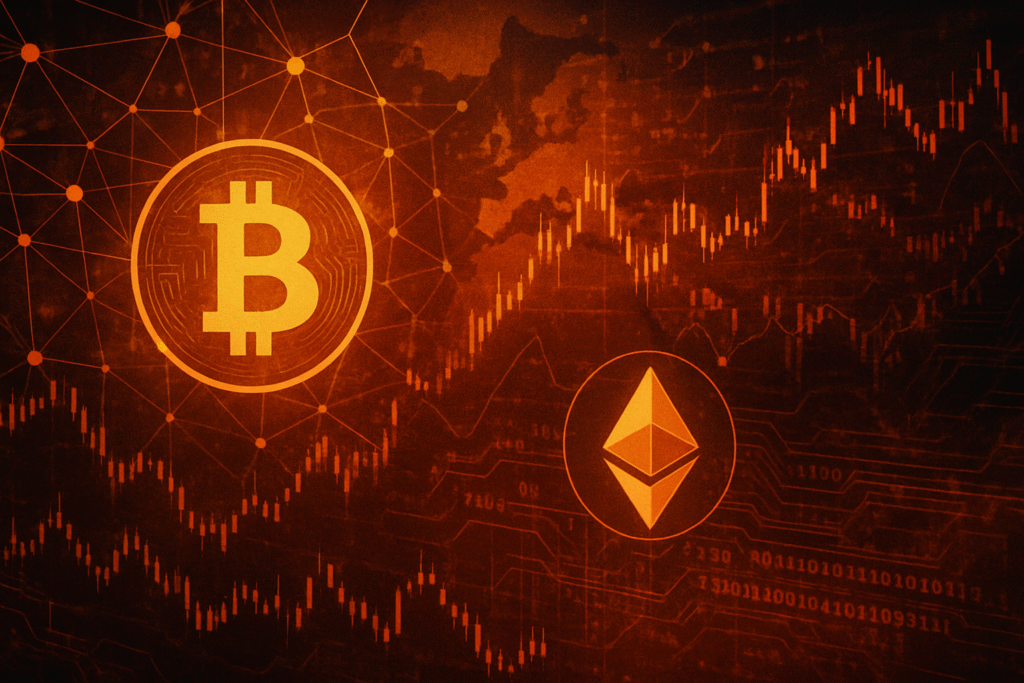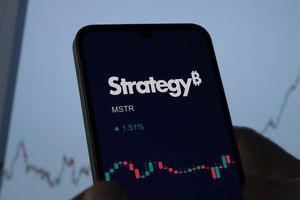
The cryptocurrency landscape has been anything but calm over the past 12-18 months, as a series of significant global geopolitical events, from a pivotal U.S. election to escalating trade wars and persistent conflicts, sent ripples of volatility through digital asset markets. As of October 3, 2025, the interplay between international politics and decentralized finance has become more evident than ever, challenging traditional notions of safe havens and highlighting crypto's dual role as both a speculative asset and a tool for financial resilience.
The period witnessed major shifts, including a pro-crypto U.S. presidential victory, renewed U.S.-China trade hostilities, continued conflict in the Middle East and Eastern Europe, and the ambitious de-dollarization efforts of the expanded BRICS bloc. Each event triggered immediate and often dramatic market reactions, fostering a dynamic environment where investor sentiment swung between fear, optimism, and uncertainty. This intricate dance underscores the growing maturity and interconnectedness of the crypto ecosystem with the broader global economic and political spheres, compelling investors and enthusiasts alike to closely monitor international developments.
Market Impact and Price Action
The financial tremors from geopolitical events manifested in distinct price movements and trading patterns across the cryptocurrency spectrum. The 2024 U.S. Presidential Election served as a significant bullish catalyst. Following Donald Trump's victory in November 2024, fueled by his public pro-crypto stance and pledges to make the U.S. a "crypto capital," Bitcoin (BTC) surged to a record high of $89,000 on November 12, 2024, representing a 30% increase in the preceding week. Dogecoin (DOGE) also saw an impressive 152% rally, reflecting widespread investor optimism for a more favorable regulatory environment.
Conversely, the U.S.-China Trade War escalations in early 2025 injected considerable volatility. In April 2025, initial U.S. tariff hikes led to market panic, with Bitcoin dropping below $78,000 and registering a cumulative 16% decline by April 8, 2025. This period saw a noticeable shift towards risk-aversion and sell-offs. A temporary tariff pause announced around April 10, 2025, provided brief respite, with Bitcoin rising 8%, Ethereum (ETH) gaining 12%, and XRP increasing by 13%. However, China's subsequent refusal of further tariff talks on April 25, 2025, immediately reintroduced uncertainty, causing Bitcoin to decline 3.2% and Ethereum 2.8% within hours, accompanied by a spike in trading volumes on major exchanges.
The ongoing Israel-Hamas Conflict and broader Middle East tensions, particularly U.S. strikes on Iranian nuclear sites and subsequent Israeli attacks on Tehran in June 2025, triggered significant market corrections. Bitcoin's price dipped below $100,000, plummeting to approximately $98,286, leading to a loss of over $35 billion in market capitalization within hours. Total liquidations across cryptocurrencies reached an estimated $656.19 million. While some initial research from October 2023 indicated that certain cryptocurrencies like BTC, Tron (TRX), Solana (SOL), and ETH experienced mostly positive abnormal returns, suggesting a "safe haven" perception by some, the June 2025 events highlighted their vulnerability to acute geopolitical shocks. The persistent Russia-Ukraine War continued to contribute to a general "risk-off" sentiment, although studies from earlier in the conflict showed that cryptocurrencies, particularly Bitcoin, demonstrated resilience and even positive correlation, suggesting a diversification potential for some investors during war-induced crises.
Finally, the BRICS Expansion and De-dollarization Efforts have created a unique dynamic. With the bloc expanding significantly by January 2024 and potentially reaching 30 countries by September 2025, discussions around alternative payment networks, local currency trade, and a common BRICS currency or crypto use have generated considerable anticipation. Analysts predict potential 10-15% swings in Bitcoin and Ethereum around major announcements. XRP, often linked to cross-border payments, was up 12% year-to-date as of October 2025, possibly reflecting market anticipation of its utility in a de-dollarizing global financial landscape.
Community and Ecosystem Response
The crypto community's response to these geopolitical shifts has been a mix of strategic positioning, fervent debate, and practical application. The 2024 U.S. Presidential Election galvanized the community, showcasing the growing influence of crypto voters. Social media platforms, particularly Crypto Twitter and Reddit, buzzed with optimism, with many influencers celebrating the potential for a more favorable regulatory environment. Pro-crypto Political Action Committees (PACs) played a significant role, raising substantial funds to back candidates aligned with the industry's interests, demonstrating a concerted effort to shape policy from within.
During periods of heightened tension, such as the U.S.-China Trade War escalations, community sentiment often shifted to caution and fear. Discussions on platforms like Reddit highlighted investors moving towards stablecoins for temporary liquidity fixes amidst the uncertainty, reflecting a defensive posture. The Israel-Hamas Conflict reignited the debate about whether cryptocurrencies truly serve as "safe haven" assets. While some investors sought refuge in Bitcoin, others viewed it as a risk asset, leading to varied sentiment across different segments of the community. The conflict also brought renewed scrutiny to the use of cryptocurrencies for financing by certain groups, prompting investigations and asset freezes by authorities, which sparked discussions about privacy versus compliance within the Web3 space.
The Russia-Ukraine War continued to underscore the practical utility of decentralized assets. The crypto community rallied to support Ukraine through significant crypto donations, which led to the Ukrainian President signing a bill legalizing the crypto sector. This demonstrated crypto's role in humanitarian aid and its ability to circumvent traditional financial systems during crises, a point often championed by crypto advocates. Furthermore, the BRICS expansion and its de-dollarization agenda have sparked considerable excitement. Many in the crypto community view this as a potential long-term catalyst for increased global crypto adoption, particularly as a neutral, censorship-resistant asset in a shifting geopolitical and financial landscape. This sentiment is often echoed by thought leaders who foresee a multipolar financial world where cryptocurrencies play a more central role.
What's Next for Crypto
The ongoing geopolitical realignments are set to have profound short-term and long-term implications for the crypto market. In the short term, market volatility is likely to remain elevated, with any significant international incident or policy announcement capable of triggering rapid price swings. Investors should brace for continued uncertainty, particularly around future developments in the U.S.-China trade relationship, the evolving Middle East situation, and the pace of BRICS' de-dollarization initiatives. The 2025 BRICS summit in Brazil is a key event to watch, as it could bring further announcements regarding a common currency or alternative payment systems, potentially causing significant market movements.
Longer term, the narrative around cryptocurrencies as a hedge against fiat instability and a neutral asset in a fragmented global financial system could strengthen. If the BRICS bloc successfully implements alternative payment networks or a common currency, it could accelerate the adoption of cryptocurrencies as a global medium of exchange, especially for cross-border transactions. This could lead to increased institutional interest and a broader integration of digital assets into international trade and finance. Projects focusing on interoperability and robust payment infrastructure, like those leveraging XRP, could see enhanced utility.
Strategic considerations for projects and investors include diversifying portfolios, closely monitoring geopolitical headlines, and understanding the nuanced reactions of different cryptocurrencies to various types of events. Projects might increasingly focus on building resilient, censorship-resistant infrastructure that can function effectively in a politically charged environment. For investors, a "wait-and-see" approach on major policy shifts, coupled with a focus on projects with strong fundamentals and clear use cases, will be crucial. Potential scenarios range from continued gradual integration of crypto into traditional finance, albeit with geopolitical friction, to a more rapid shift towards decentralized finance as an alternative to state-controlled systems if global tensions escalate further.
Bottom Line
The past 12-18 months have unequivocally demonstrated that cryptocurrency markets are no longer isolated from global geopolitical currents. From the electoral politics of the United States to the complex dynamics of international trade and conflict, external events exert a powerful influence on digital asset prices and investor sentiment. Key takeaways for crypto investors and enthusiasts include the necessity of geopolitical awareness, the understanding that crypto's "safe haven" narrative is complex and context-dependent, and the recognition of its growing utility as a tool for financial freedom and resilience in times of crisis.
The long-term significance of these events lies in the accelerated integration of cryptocurrencies into the global financial and political discourse. The push for de-dollarization by the BRICS nations, coupled with the proven utility of crypto in humanitarian efforts and circumventing sanctions, positions digital assets as a significant player in the evolving world order. This means a future where crypto adoption is not just driven by technological innovation but also by geopolitical necessity and strategic advantage.
Final thoughts suggest that while volatility will persist, the fundamental value proposition of decentralized, permissionless finance continues to gain traction on the global stage. Important dates and metrics to monitor include upcoming BRICS summits, U.S. and Chinese economic data and trade policy announcements, and any escalations or de-escalations in ongoing international conflicts. The market capitalization, trading volumes, and institutional adoption rates of major cryptocurrencies will serve as crucial indicators of crypto's ongoing journey towards mainstream acceptance amidst a turbulent global landscape.
This article is for informational purposes only and does not constitute financial or investment advice. Cryptocurrency investments carry significant risk.





